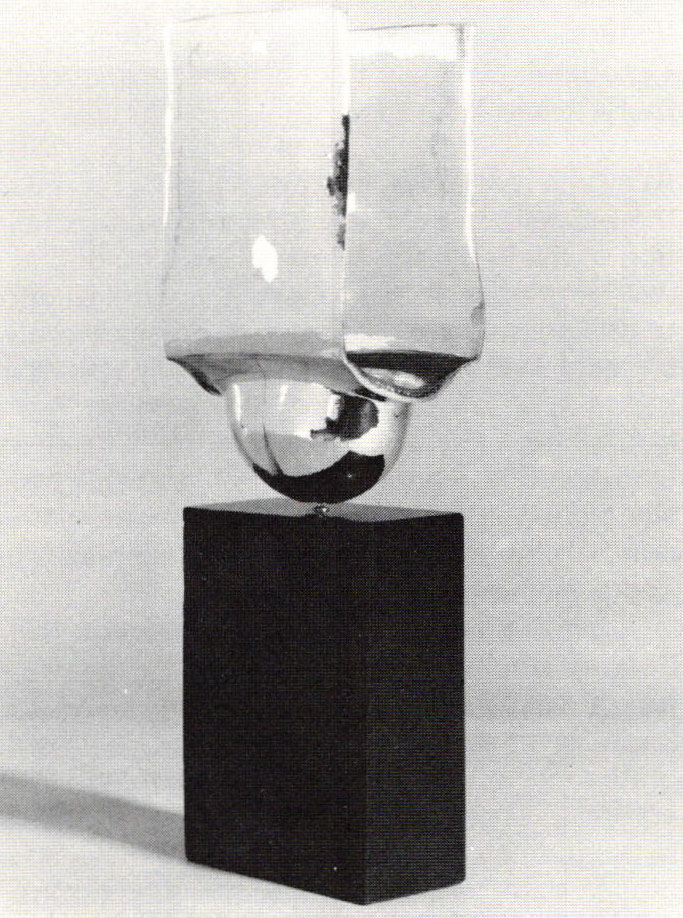The Work of John Marshall
2 Minute Read
The success of John Marshall's art, as a practicing metalsmith, was evident in this impressive exhibition. Held in conjunction with the 1983 Society of North American Goldsmiths Conference at Asilomar, Marshall's show was the visual and esthetic high point of the goldsmiths' gathering. This comprehensive exhibition was about where John's work is, stylistically.
John Marshall
Concepts Gallery, Carmel, CA
May 29-June 30, 1983
There were several early pieces—wonderfully crafted teapots with sugar and creamer—several fairly recent pieces—raised sterling forms on carved acrylic bases, with cool, frosted finishes and some parts crystal clear—and new departure pieces, incorporating carved and polished basalt stone with raised, formed, chased and engraved sterling forms arranged in cantilevered dynamism.
There was a rawness in the stone elements that evoked a sense of nature's latent power, a feeling of primordial origins. These were not the too, too finished surfaces of earlier pieces, of another time, and an earlier Scandinavian influence. Here we saw in Marshall's work a sense of the mature designer introducing another element, basalt, into his ongoing dialogue with metal. There was a sense of permanence about these new pieces and a sense of an understood historic perspective, not derivative of stonecarving sculptors of the past, but with an implied acknowledgment to the stone monument builders. These new pieces were not large, but they possessed a certain monumentality. The sensitive use of stone and sterling as esthetic statement, suggested an understanding of these materials in a way similar to Isamu Naguchi's images in stone.
Some of Marshall's stone elements are geometric shapes, some are monolithic slabs with one or two polished surfaces contrasting with the raw cleavage of the natural surface. And attached to these, in wonderfully precarious positions, are the silver forms that seem to sometimes float above the stone and are yet tethered to them. The exhibition consisted of bowls, candelabra, vases, cocktail servers, pure sculptural forms and even jewelry embodying basalt. Several pieces were breathtaking; all were worthy of careful attention.
Finally, I mention the quintessential work of the exhibition, The Winged Bowl. While this piece has been exhibited with both an acrylic base and a basalt base, its singular beauty is of a quality that sets it apart from its fine companion pieces. This sterling bowl of such contemporary design suggests several historic references. Among them is the classical Greek sculpture, "Winged Victory," or perhaps a Japanese Samurai helmet. In any case, it is beautifully crafted metal, with small but important detailing, like the thickened edges, a fantastic effect, for those who know and love metal.
You assume all responsibility and risk for the use of the safety resources available on or through this web page. The International Gem Society LLC does not assume any liability for the materials, information and opinions provided on, or available through, this web page. No advice or information provided by this website shall create any warranty. Reliance on such advice, information or the content of this web page is solely at your own risk, including without limitation any safety guidelines, resources or precautions, or any other information related to safety that may be available on or through this web page. The International Gem Society LLC disclaims any liability for injury, death or damages resulting from the use thereof.
The All-In-One Jewelry Making Solution At Your Fingertips
When you join the Ganoksin community, you get the tools you need to take your work to the next level.
Trusted Jewelry Making Information & Techniques
Sign up to receive the latest articles, techniques, and inspirations with our free newsletter.
